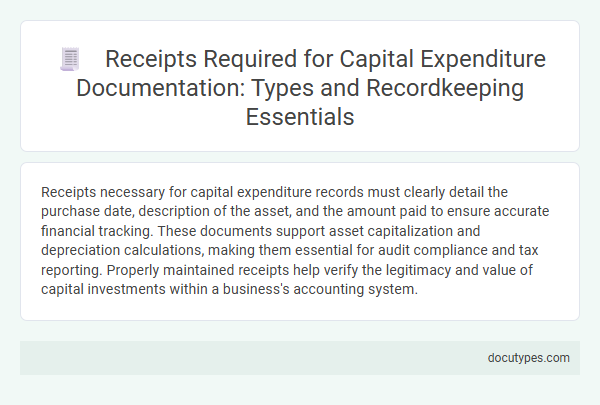Receipts necessary for capital expenditure records must clearly detail the purchase date, description of the asset, and the amount paid to ensure accurate financial tracking. These documents support asset capitalization and depreciation calculations, making them essential for audit compliance and tax reporting. Properly maintained receipts help verify the legitimacy and value of capital investments within a business's accounting system.
Introduction to Capital Expenditure Documentation
Capital expenditure documentation is essential for accurate financial reporting and asset management. Proper receipts serve as proof of purchases and investments in long-term assets.
Receipts necessary for capital expenditure records include invoices, purchase orders, and payment confirmations. These documents ensure compliance with accounting standards and facilitate audit processes.
Importance of Receipts in Capital Expenditure
Receipts play a crucial role in documenting capital expenditures accurately for accounting and audit purposes. Proper receipt management ensures transparency and compliance with financial regulations.
- Proof of Purchase - Receipts serve as official evidence of asset acquisition and expenditure amount.
- Financial Accuracy - They help maintain precise records necessary for asset valuation and depreciation calculations.
- Audit Trail - Receipts create a verifiable trail, facilitating internal audits and external financial reviews.
Your ability to present clear receipts strengthens the reliability of your capital expenditure records.
Types of Capital Expenditure Requiring Receipts
Receipts for capital expenditure records must include invoices, purchase orders, and payment confirmations related to asset acquisition or improvement. Types of capital expenditure requiring receipts include property purchases, machinery and equipment acquisitions, and major renovations or upgrades to existing assets. You need these documents to ensure accurate accounting and compliance with financial regulations.
Essential Receipt Details for Compliance
Receipts necessary for capital expenditure records must clearly detail the item purchased, including its description, quantity, and unit price. These receipts provide verifiable proof of asset acquisition essential for accurate financial reporting and tax compliance.
Essential receipt details include the date of purchase, vendor information, and payment method to establish authenticity and traceability. Maintaining complete capital expenditure receipts ensures adherence to accounting standards and supports audit requirements effectively.
Acceptable Formats for Receipt Documentation
Receipts are crucial for maintaining accurate capital expenditure records to ensure compliance and audit readiness. Proper documentation in accepted formats helps validate your financial transactions clearly and efficiently.
- Paper Receipts - Physical copies must be clear, legible, and include detailed transaction information.
- Electronic Receipts - Digital copies such as PDFs or scanned images are widely accepted and easy to store securely.
- Itemized Receipts - Receipts should itemize purchases to provide transparency on individual capital assets acquired.
Electronic vs. Paper Receipts: Pros and Cons
Receipts are essential for documenting capital expenditures, ensuring accuracy and compliance in financial records. Choosing between electronic and paper receipts impacts storage, accessibility, and audit readiness.
- Electronic receipts offer easy storage and quick retrieval - Digital formats reduce physical clutter and improve search efficiency for capital expenditure records.
- Paper receipts provide a tangible audit trail - Physical copies are often preferred for legal compliance and verification in capital asset accounting.
- Electronic receipts risk data loss without proper backups - Technical failures or cyber threats can compromise vital financial evidence.
Organizing and Storing Capital Expenditure Receipts
| Receipt Type | Importance for Capital Expenditure Records | Organizing Tips | Storage Recommendations |
|---|---|---|---|
| Purchase Invoices | Document the acquisition cost of assets and verify financial transactions. | Sort by vendor and date for easy reference during audits. | Store digitally with backup copies; keep physical copies in labeled folders. |
| Payment Receipts | Proof of payment ensures accuracy in capital expenditure tracking. | Match with corresponding purchase invoices to validate expenses. | Use secure digital receipt management software with encryption. |
| Contract Agreements | Detail terms of purchase and installation costs related to capital assets. | File by project or asset type to streamline retrieval. | Archive in both physical binders and cloud storage solutions. |
| Installation and Maintenance Receipts | Record costs related to setting up or maintaining capital assets for accurate cost allocation. | Group receipts by asset and service date for clear expense tracking. | Keep originals with asset records; scan copies for digital backup. |
| Depreciation Schedules | Support calculation of asset value reduction over time within capital expenditure reporting. | Update regularly and organize by fiscal year and asset category. | Store electronically with audit trail functionality. |
Audit Requirements for Receipt Recordkeeping
Receipts necessary for capital expenditure records must include detailed documentation such as purchase invoices, payment proofs, and delivery confirmations to ensure accurate tracking of asset acquisitions. These records are critical during audits to verify the legitimacy and valuation of capital assets listed in financial statements. Maintaining organized, complete receipts supports compliance with regulatory standards and facilitates thorough audit verification processes.
Common Receipt Recordkeeping Mistakes to Avoid
What receipts are necessary for capital expenditure records? Proper documentation includes purchase invoices, vendor receipts, and payment confirmations. These documents ensure accurate tracking and compliance with accounting standards.
What common receipt recordkeeping mistakes should be avoided? Failing to retain original receipts, mixing personal and business expenses, and incomplete documentation can lead to discrepancies. Maintaining organized and detailed records prevents errors and supports financial audits effectively.
What Receipts Are Necessary for Capital Expenditure Records? Infographic

